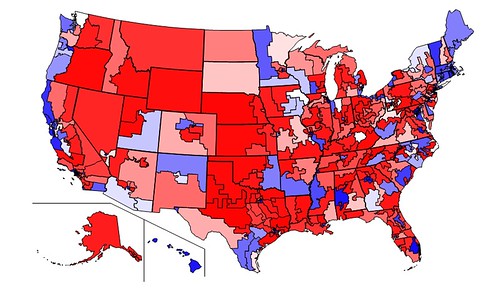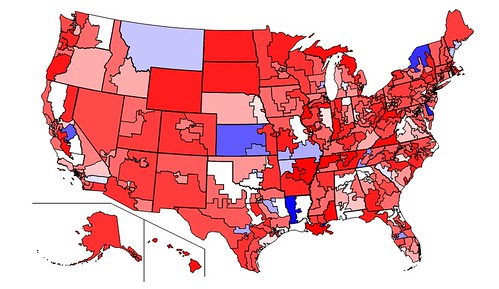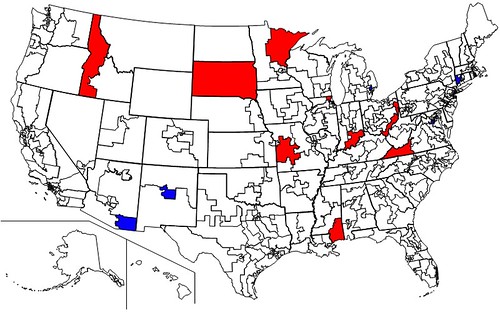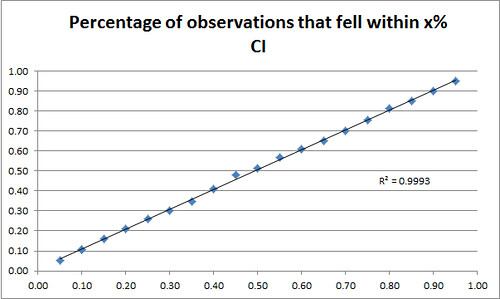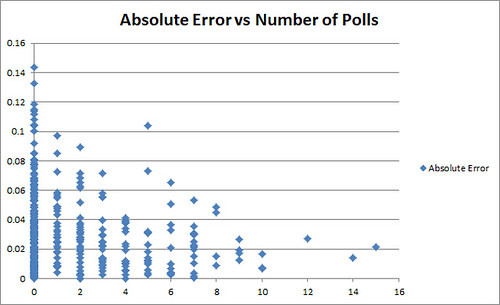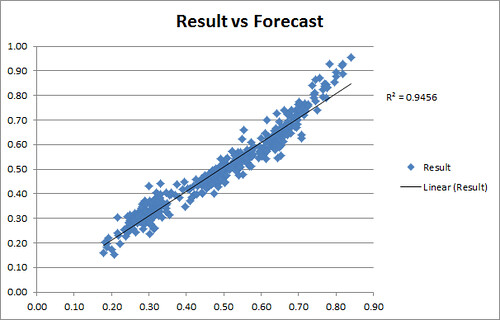***cross-posted at DailyKos***
If you haven’t seen it yet, yesterday DailyKos presented a poll that was conducted for us by Public Policy Polling, a North Carolina-based Democratic polling firm. Despite it’s affiliation with the Democrats, PPP doesn’t have a big noticeable House effect though.
The poll’s results were an absolute shocker: (relatively conservative) Democrat Jon Hulburd leads the former Vice President’s son Ben Quayle 46-44 in the district that is still held by retiring Republican Representative John Shadegg, one of the most conservative Republicans in the House, in a district that has a Cook PVI of R+9- that means that in the last few election cycles it voted on average 9 points more Republican than the nation as a whole.
John McCain, who admittedly stems from Arizona, won 57% of the vote there, Bush got 54% in 2000 and 58% in 2004.
Another note: The huge paragraph breaks are intentional. They don’t look very aesthetically pleasing, but I think that without them the numerical density of the diary would pretty much kill every reader.
In such a bad cycle as 2010, where the general consensus is that Democrats are going to lose about 50 House seats, you’d expect a Democrat to be down at least by 15-20 points here- if not more.
So understandably lots of people questioned the validity of the poll. I’m going to dig a bit into the raw data, that’s provided for all joint DailyKos/PPP polls. A big hurrah to transparency!
Still, unless you like to see a lot of numbers, you can just skip to the conclusion, in the main part of the diary (and it will be long, I guess) I describe how I got there.
Basically, the analysis will have three steps:
1) We will look at several crosstabs that PPP/DailyKos didn’t provide in their tables in the release.
2) We will look at where Hulburd and Quayle fall short of the potential ceiling for Democrats and Republicans respectively in the district.
3) We will take a sophisticated look at undecided voters and how they might break down.
Raw Polling Data and the Question Key.
Okay, the first thing we can use this for is to provide a couple of crosstabs that PPP/DailyKos didn’t release.
They’re not very surprising: Across the board, Hulburd does a better job holding on to voters for other Democratic candidates/people who approve of Democratic politicians than Quayle does with Republicans.
Hulburd wins 91-7 among the people who vote for Terry Goddard, Quayle wins 79-10 among Gov. Brewer’s supporters. Gubernatorial undecideds break 32-10 for Hulburd.
Hulburd wins Rodney Glassman’s supporters by an almost identical 90-7 margin, Quayle wins Sen. McCain’s supporters, but only by a 72-19 margin. The support that Senator McCain still has left among moderates who don’t rubberstamp all Republicans is not transferring to Quayle.
Senatorial Undecided voters break for Quayle 36-29- fueled by some people who don’t back McCain but most other Republicans- I guess some JD Hayworth supporters are still out there.
Not very surprisingly, Hulburd wins people who see him favorably, 88-8, and loses people who don’t like him 85-11. People who are still undecided about him go for Quayle by a 55-30 margin- maybe Hulburd has some room to grow here as people make up their minds about him and Quayle.
Quayle wins people who like him by a whooping 97-2 margin. That is mostly because almost no one likes him, and if you do, you’re such a hardcore supporter that you certainly will vote for him too. He loses people who view him unfavorably 8-85, and is saved by the fact that people who don’t have an opinion on him go for him 54-11.
I’m somewhat hoping that these are low-information voters who haven’t read much about the race and just went by the Party name provided: The Republicans are strong here, so their brand isn’t as much in the gutter here as elsewhere. As media coverage will ramp up in the last two weeks, hopefully some of these will learn about Quayle’s scandals.
I’m skipping how the people who view Brewer/McCain/Goddard/Glassman/Kyl favorably/unfavorably/not at all break down, because it is totally unremarkable: People who like Democrats vote for Hulburd, people who like Republicans vote for Quayle, people who don’t have a clue vote for Quayle by a lesser margin. If you’re interested though, ask in the comments, I have the data lying around.
Now, as for Obama… Obama’s image in this district is terrible, with his approval at 38% and his disapproval at 55%.
It’s no big surprise that Hulburd managed to shore up all supporters of President Obama, he wins them 95-2: That’s a better predictor than even how people view him or Quayle!
Hulburd also manages to win over 13% of people who disapprove of Obama, a (in today’s times) relatively huge amount of cross-over. Quayle gets 75% here. Among the few people who are still undecided on how they view Obama, Hulburd wins 57-19. I guess that if in such a red district you don’t hate Obama you’re pretty much a Democrat-leaning guy.
Not very surprisingly, Hulburd wins people who disapprove of the broadly popular SB-1070 90-7, because this mostly comes down to Liberals and Hispanics. He manages to win over almost a quarter of people who LIKE the law though, losing them only 22-67. This is what keeps him alive here, as 59% of voters like the law, just 34% don’t.
It’s no big surprise that Hulburd came out in favor of the law- we might not like it, but if he came out against it, he’d probably be down by 6-7 points despite of Quayle’s weaknesses.
On a related note, this is also why Raul Grijalva seems to be in a bit of trouble. If you call for a boycott of your own constituents because of a law that is supported by a majority of voters, that will not play very well with anyone, really.
Summary: Hulburd is competitive because he does much better with otherwise Republican-leaning people than Quayle does with Democrat-leaning people, and because he supports SB-1070, which enables him to win over a good chunk of the 59% of people who support it too.
Okay, great. But this was not really in-depth analysis so far.
The next step is looking at the potential that Democrats and Republicans have in the district, and where Hulburd and Quayle fall short of it.
I did this already for my first analysis of a PPP/Kos poll, and I was pretty satisfied with the interpretative value it provided.
The potential for Democrats and Republicans is defined as follows:
People who support at least one of Hulburd, Glassman, Goddard, or Obama in 2008, or who identify themselves as Democrats are among the reachable voters for Democratic candidates. A perfect Democratic candidate without weaknesses running against a flawed Republican could win them all. Roughly 58% of voters in the district belong to the this category, which could be termed the Democratic Persuadable Voter Universe (DPVU.. okay, I love appreviations).
People who support at least one of Quayle, McCain, Brewer, McCain in 2008 or who identify themselves as Republicans are in the RPVU universe (Republican Persuadable.. okay, you know the drill). That works out to a bit less than 70% of voters in this district.
Or, put another way, 30% of voters usually vote a straight Democratic ticket, 42% of voters usually vote a straight Republican ticket, and 28% of voters are swing voters who can be persuaded by both parties.
What are the characteristics of the people who are open to Democrats, but don’t support Hulburd, and what are the characteristics of the people who are open to Republicans, but don’t support Quayle?
Let’s clarify first that the latter group is much bigger than the former. Quayle reaches only about 62% of the many voters who might have supported a good Republican candidate, Hulburd gets almost 80% of his potential supporters.
Now let’s look at the potential Dems who don’t support Hulburd.
They support Brewer over Goddard, 55-35, McCain over Glassman, 57-36, dislike Hulburd 17-26, like Quayle 58-20, Brewer 61-27, McCain 57-34, Kyl 51-23, dislike Goddard 32-53, Glassman 12-27, and Obama by a whooping 16-74 margin. They like SB-1070 69-19 BUT they only supported McCain over Obama by a 48-40 margin.
10% of them are liberal, 41% moderate, 49% Conservative, 61% female, 31% of them still identify as Democrats, 47% as Republicans, and 22% as Independents. 79% are White, 16% are Hispanic and 5% something else. Age breakdown is pretty irrelevant because largely similar to everyone else.
Okay, I think we can put these people into a three groups.
About 55% of them are Republicans or Republican-leaning Independents who happened to like one of Glassman, Goddard or Obama in 2008.
About 25% of them are Democrats or Democratic-leaning Independents who are now in the Obama disapproval camp, but still support some statewide Democrats like Glassman or Goddard. They don’t like Hulburd, or are still undecided on the race (Remember, we’re talking about ‘NOT SUPPORTING HULBURD’-Dems, not about ‘SUPPORTING QUAYLE’-Dems. The Undecided Dems are in here, too).
The last 20% are liberal or moderatish liberal Democrats who still like Obama, and statewide Democrats, dislike SB 1070 and are generally party-line Democrats, but still don’t support Hulburd.
These are the people he can’t afford to lose- he doesn’t have to get to his ceiling of 58%, but these last 20% of people Hulburd HAS to convince.
He should also try to firm up at least a bit of support among the Dems who have soured on Obama. If he does that, he’ll get closer to the 50% mark.
Okay, let’s do the same thing for the Republican-leaning group that doesn’t support Quayle: A much larger group.
They back Goddard over Brewer, but just barely, 48-43, and McCain over Glassman, by a huge margin, 61-30.
Here we already see a key difference: The Democrats who don’t support Hulburd soured on the WHOLE ticket, voting for Brewer and McCain.
The Republicans who don’t like Quayle draw a line there, but still are relatively open to people like McCain and to a lesser extent Brewer, suggesting that they don’t want to vote for very conservative wingnuts, but are open to supporting moderate and potentially sane conservative (Kyl) Republicans.
They like Hulburd, who’s a quite conservative Democrat, by a 45-8 margin. And they fucking HATE Quayle, with 7% viewing him favorably, and 76% unfavorably. Contrast that 7-76 rating with Hulburd’s 17-26 rating among his own defectors. Quayle’s defectors hate him, Hulburd’s defectors are merely ‘Meh’ about him.
They’re split on Brewer, giving her a 42-47 rating, and Kyl, who gets a 42-44 rating from them, but like McCain, 58-31. They also like Goddard, 53-32, and are not sure about Glassman, giving him a 20-19 rating.
Even though they don’t support Quayle and like many more moderate Democrats like Goddard and Hulburd, they’re not too fond of Obama though, who gets a 40-48 rating from them. Also, they back the SD-1070 bill, though to a lesser extent than the electorate as a whole, 53-34.
They voted for McCain in 2008, giving him 57% of their votes to Obama’s 31%.
10% are liberal, 57% moderate, and 34% Conservative, 56% female, 24% Democrats, 57% Republicans (!) and 19% Independent. 80% are White, 14% Hispanic, 6% Other, age breakdown is unremarkable once again.
So… essentially we have similar groups here, but the breakdown is a bit different. And we have one new group.
30% are essentially Democrats who happen to like a Republican (mostly McCain) but generally vote party-line on most cases.
About 40% are Republicans who generally support the party line, like Kyl and Brewer and SD-1070, but are disgusted by Quayle and therefore don’t support him. These are the people who like Brewer and Kyl and McCain, but not Quayle.
About 15% are moderates who generally support the middle-of-the-road candidate everywhere. They supported McCain in 2008, still love him, but they also like Goddard and back him over Brewer. They’re not really down on Glassman, but would never back him over McCain. They don’t like Obama, but they do like Hulburd, who’s running as a moderate Democrat supporting SB 1070, which they also like, and against an inept wingnut like Quayle.
And about 15% are Democrats who have soured on Obama, and vote much like the moderates.
All of these people have one thing in common: They hate Dan Quayle, which is why he’ll have a very hard time winning them over. He’ll get some of them because a lot of these people still don’t want a Democratic Congress and will- disgusted- still back him, but not that many.
Here’s an interesting statistic:
Looking at all moderate AND liberal Republicans, who make up about 18% of the sample, Quayle wins just by a measly 48-42 margin. That means that almost half of the moderate Republicans have abandoned him, that is huge.
As a comparison, looking at all moderate and conservative Democrats, a subsample that’s about the same size as the moderate and liberal Republicans, Hulburd wins 84-10. If the candidates were equally appealing, these numbers should be roughly the same. There you can see the huge difference between the candidate’s qualities.
Summary: While Hulburd still has some work to do with winning over some Democrat-leaning voters who still hold out on him, especially those who still like the other Democrats on the ticket, the main point here is just how unpopular Quayle is. Lots of conservative Independents and moderate Republicans and even conservative Republicans who usually are very open to Republican candidates have left his campaign. Some of them are already on board with the Hulburd campaign, some are still out there and thinking about their choice.
Okay, the last thing we’ll do is look at the Undecided voters. For that we need an advanced tool, a so-called Logistic Regression.
The short story is, without going into the math details, we’re looking at the voters who already have decided, and try to discern WHY they voted that way. We do that by looking at the other responses they gave in the poll. If they disapprove of Obama, voted for McCain, and are Conservative Republicans, who support Brewer over Goddard, we can be pretty sure that they will support Quayle: And we can quantify that and give them a certain probability that they will support Candidate A or B.
The result of this is some output that probably few of you would understand, so I’m not going to copy it here. If you want to see it, leave a message in the comments and I’m going to post it there.
The model has an adj. r² of .81 though, for the stats guys, which means that it explains 81% of the variance in the dependent variable (If the voter supports the Democrat).
Okay, the results here are not as good. The model projects that Hulburd will draw only 42% of the remaining undecided voters, with 58% going to Quayle. The main reason for that is that there are many people like #648 among the Undecided voters: She’s a white, conservative Republican aged 65+, voted for McCain and still likes him. She dislikes Obama, likes SB1070, and she doesn’t like Goddard- she doesn’t like Gov. Brewer either though. That’s why she’s undecided on the Gubernatorial race while she’s voting for McCain. She doesn’t like Quayle, and has no opinion yet on Hulburd.
The model assigns her a 76% chance that she finally will come home and vote for Quayle though, voting party line over her personal feelings.
For others the choice goes the other way. #644 has a similar profile: She, too, is a female senior white Conservative who dislikes Quayle and likes SB1070. But, she likes Hulburd too, while #648 was just undecided on him. And, she’s different on the gubernatorial race. While #648 disliked both Goddard and Brewer, she likes them both- still, she’s voting for Brewer. OTOH, she’s not as warm towards McCain anymore, having no opinion about him and still being undecided on the Senate race.
For her, the model thinks, her high opinion of Hulburd and her dislike of Quayle could make a difference, so the model gives her a 75% chance of voting for Hulburd and 25% for Quayle.
Still, among all undecided voters, on average 58% will break for Quayle and 42% for Hulburd. That almost erases Hulburd’s lead. Allocating the undecided voters results in a result of 50.1% for Hulburd to 49.9% for Quayle.
Summary: The demographics and responses of the remaining undecided voters suggest that Ben Quayle will gain the majority of their votes, 58-42. Allocating the undecideds that way results in a essentially tied race, 50.1-49.9% in favor of Hulburd.
Conclusion: The results of the PPP poll look pretty reasonable. Voters of all colors dislike Quayle and many of them follow this up by voting for Hulburd. Almost half of moderate Republicans vote for Hulburd, as do many voters who favor the SB-1070 bill. Hulburd’s conservative profile makes him a viable alternative for Republicans and conservative Independents who dislike Quayle, while he still holds the liberal part of his base together. Hulburd wins over many Conservatives and Republicans, while Quayle gets almost no cross-over support. That makes Hulburd competitive in this race where the fundamentals favor Quayle: 42% of voters here usually vote straight-ballot GOP– compared to 30% who do the same for the Democrats. But Hulburd wins over most swing voters.
The upside for Quayle in this poll is that the Undecided voters in this poll largely favor him, I project 58% of undecided voters to break for Quayle and 42% for Hulburd. This makes the AZ-03 election an absolutely tied race, with outprojecting the undecideds 50.1% voting for Hulburd and 49.9% for Quayle.
This race should come down to a couple of thousand votes, unless Quayle succeeds in making an argument that GOP voters and Conservatives should somehow forget their feelings for him in the ballot box.
